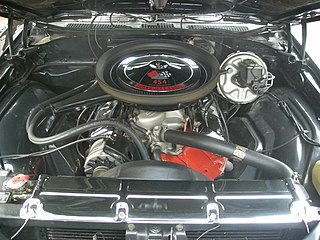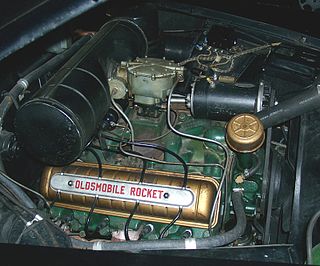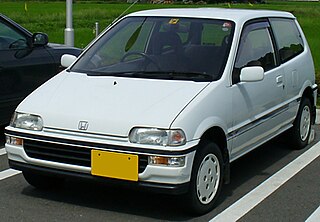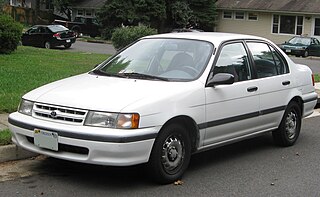
The Peugeot 106 is a supermini produced by French automaker Peugeot between 1991 and 2003. Launched in September 1991, it was Peugeot's entry level offering throughout its production life, and was initially sold only as a three-door hatchback, with a five-door hatchback joining the range in the beginning of 1992. Production ended in July 2003.

The Ford FE engine is a V8 engine produced by the Ford Motor Company and used in vehicles sold in the North American market between 1958 and 1976. The FE, derived from 'Ford-Edsel', was introduced to replace the short-lived Ford Y-block engine, which American cars and trucks were outgrowing. It was designed with room to be significantly expanded, and manufactured both as a top-oiler and side-oiler, and in displacements between 332 cu in (5.4 L) and 428 cu in (7.0 L).

The Metro is a supermini car, later a city car that was produced from 1980 to 1998, first by British Leyland (BL) and later by the Rover Group. It was launched in 1980 as the Austin Mini Metro. It was intended to complement and eventually replace the Mini, and was developed under the codename LC8. The Metro was named by What Car? magazine as "Car of The Year" in 1983 as an MG, and again as the Rover Metro in 1991.
The Honda XR series is a range of four-stroke off-road motorcycles that were designed in Japan but assembled all over the world.

The Subaru Rex, also known as Ace, Viki, Sherpa, 500/600/700, Mini Jumbo, Mini Subaru or M60/M70/M80 in various export markets, is a kei class automobile produced from 1972 to 1992 mainly for sale in Japan by Subaru, although it was also sold in Europe, South America, Australia and the Caribbean. The Rex superseded the R-2 as Subaru's kei car, and has been available in commercial use versions as well as in a passenger car version. It underwent major changes in 1976, in fall 1981, and again in late 1986. The second generation Rex (1981–1986) also formed the basis for the larger Subaru Justy.

The Ford small-block is a series of 90° overhead valve small-block V8 automobile engines manufactured by the Ford Motor Company from July 1961 to December 2000.

The Chevrolet "big block" engine is a term for a series of large-displacement, naturally-aspirated, 90°, overhead valve, gasoline-powered, V8 engines; that were developed and produced by the Chevrolet Division of General Motors, from the 1950s until present.

The Chevrolet small-block engine is a series of gasoline-powered V8 automobile engines, produced by the Chevrolet division of General Motors between 1954 and 2003, using the same basic engine block. Referred to as a "small-block" for its size relative to the physically much larger Chevrolet big-block engines, the small block family spanned from 262 cu in (4.3 L) to 400 cu in (6.6 L) in displacement. Engineer Ed Cole is credited with leading the design for this engine. The engine block and cylinder heads were cast at Saginaw Metal Casting Operations in Saginaw, Michigan.

The Pontiac V8 engine is a family of overhead valve 90° V8 engines manufactured by the Pontiac Division of General Motors Corporation between 1955 and 1981. The engines feature a cast-iron block and head and two valves per cylinder. Engine block and cylinder heads were cast at Saginaw Metal Casting Operations then assembled at Tonawanda Engine before delivery to Pontiac Assembly for installation.

The GA engine is a 1.3 to 1.6 L inline-four piston engine from Nissan. It has a cast-iron block and an aluminum head. There are SOHC and DOHC versions, 8, 12, and 16 valve versions, carbureted, single-point, and multi-point injected versions, and versions with variable valve timing (GA16DE). The GA was produced from August 1987 through 2013. Since 1998, it was only available from Mexico in the B13.

The Nissan S30, sold in Japan as the Nissan Fairlady Z and in other markets as the Datsun 240Z, then later as the 260Z and 280Z, is a grand tourer produced by Nissan from 1969 until 1978. The S30 was conceived of by Yutaka Katayama, the President of Nissan Motor Corporation U.S.A., and designed by a team led by Yoshihiko Matsuo, the head of Nissan's Sports Car Styling Studio. It is the first car in Nissan's Z series of sports cars.

The Oldsmobile V8, also referred to as the Rocket, is a series of engines that was produced by Oldsmobile from 1949 until 1990. The Rocket, along with the 1949 Cadillac V8, were the first post-war OHV crossflow cylinder head V8 engines produced by General Motors. Like all other GM divisions, Olds continued building its own V8 engine family for decades, adopting the corporate Chevrolet 350 small-block and Cadillac Northstar engine only in the 1990s. All Oldsmobile V8s were manufactured at plants in Lansing, Michigan while the engine block and cylinder heads were cast at Saginaw Metal Casting Operations.

Gurgel Motores was a Brazilian automobile manufacturer, named after its founder João do Amaral Gurgel. The company was founded in 1969 and first specialised in buggies and off-road vehicles. Early models were fiberglass bodies installed on Volkswagen Beetle chassis and machinery, but VW bodies and chassis were later replaced by a unique solution made of Plasteel, which consists of fiberglass and steel joined, a system patented by Gurgel. Gurgel also introduced Brazil's first fully domestically designed and manufactured car, the BR-800.

The E-series was a line of inline four-cylinder automobile engines designed and built by Honda for use in their cars in the 1970s and 1980s. These engines were notable for the use of CVCC technology, introduced in the ED1 engine in the 1975 Civic, which met 1970s emissions standards without using a catalytic converter.

The Honda Today is a kei car produced by Japanese automaker Honda beginning in 1985. It was replaced by the Honda Life in 1998.

The Chrysler Hemi engines, known by the trademark Hemi or HEMI, are a series of American V8 gasoline engines built by Chrysler with overhead valve hemispherical combustion chambers. Three different types of Hemi engines have been built by Chrysler for automobiles: the first from 1951 to 1958, the second from 1964 to 1971, and the third from 2003 to 2024. Although Chrysler is most identified with the use of "Hemi" as a marketing term, many other auto manufacturers have incorporated similar designs. The engine block and cylinder heads were cast and manufactured at Indianapolis Foundry.

The Suzuki G engine is a series of three- and four-cylinder internal combustion engines manufactured by Suzuki Motor Corporation for various automobiles, primarily based on the GM M platform, as well as many small trucks such as the Suzuki Samurai and Suzuki Vitara and their derivatives.

The Toyota Tercel is a subcompact car manufactured by Toyota from 1978 until 1999 across five generations, in five body configurations sized between the Corolla and the Starlet. Manufactured at the Takaoka plant in Toyota City, Japan, and sharing its platform with the Cynos and the Starlet, the Tercel was marketed variously as the Toyota Corolla II — sold at Toyota Japanese dealerships called Toyota Corolla Stores — and was replaced by the Platz in 1999. It was also known as the Toyota Corsa and sold at Toyopet Store locations. Starting with the second generation, the Tercel dealership network was changed to Vista Store, as its badge engineered sibling, the Corolla II, was exclusive to Corolla Store locations.

The Volkswagen G60 and G40 were inline-four cylinder automobile petrol engines, which uses a specific method of forced induction by way of a scroll-type supercharger. The G60 engine was formerly manufactured by the German automaker Volkswagen Group and was installed in a limited number of their 'hot hatch' cars from their Volkswagen Passenger Cars marque from August 1988 to July 1993.

The Gurgel BR-800 is a Brazilian city car produced by Gurgel between 1988 and early 1992. The project started under the acronym CENA, meaning "National Economical Car", designed to be essentially a small car for urban daily use. It received great attention and good reviews from critics, regarding the mechanic solutions, comfort, drivability and stability. When it was introduced in September 1987, the car was named the Gurgel 280 but by the time sales started it was changed to the BR-800. The car could only be purchased if the buyer also bought 750 shares in Gurgel, making it considerably more expensive than the much bigger and more capable Chevrolet Chevette, the then cheapest new car available in Brazil.



















